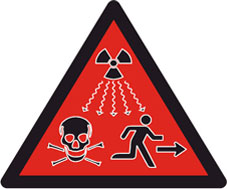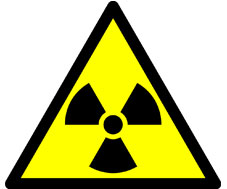Ionizing Radiation and Humans – The Basics
Most people fear ionizing radiation. Certainly it can cause death if we are exposed to too much, and the most recent symbol for it makes it clear to stay away from it. However, ionizing radiation, like many things, isn’t bad unless a living organism is exposed to too much of it.
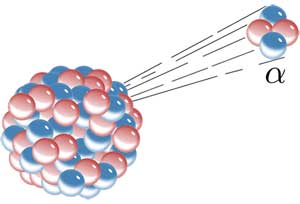
Alpha decay: a nucleus ejects an alpha particle which is identical to an ionized helium nucleus.
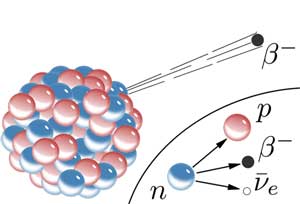
Beta minus decay happens when a neutron within an atom's nucleus transforms into a proton and an electron and an antineutrino are ejected out of the nucleus of an atom. For a beta plus decay a proton transforms to a neutron and a positron (similar to an electron but with a positive charge) and a neutrino are ejected out of the nucleus.
Ionizing radiation is any type of particle or electromagnetic wave that carries enough energy to ionize or remove electrons from an atom. There are two types of electromagnetic waves that can ionize atoms: X-rays and gamma-rays, and sometimes they have the same energy. Gamma radiation is produced by interactions within the nucleus, while X-rays are produced outside of the nucleus by electrons. There are officially two types of ionizing radiation that are energetic particles emitted during an interaction within the nucleus. The alpha particle is composed of two protons and two neutrons, or a helium nucleus ![]() . The beta particle is either a positron or an electron. Neutrons emitted during some nuclear decay processes are often included as ionizing particles but they do not actually ionize an atom directly. Neutrons interact with another nucleus, which may result in a secondary process involving ionizing radiation.
. The beta particle is either a positron or an electron. Neutrons emitted during some nuclear decay processes are often included as ionizing particles but they do not actually ionize an atom directly. Neutrons interact with another nucleus, which may result in a secondary process involving ionizing radiation.
Why is ionizing radiation dangerous? When atoms in living cells become ionized one of three things usually happen – the cell dies, the cell repairs itself, or the cell mutates incorrectly and can become cancerous. Not all cells are affected by ionizing radiation in the same way. The cells that reproduce the most and are the least specialized are the most likely to be affected by ionizing radiation, for example those in a forming fetus.1
Radiation is effective as a cancer treatment because it can kill the cancer cells, however it can also kill or damage nearby cells. When radiation is used to treat cancer it must be pinpointed very carefully. New technologies, similar to imaging techniques used in CT scans, called TomoTherapy help pinpoint radiation treatment.2 TomoTherapy allows radiologists to apply the ionizing energy directly to the perimeter and within the tumor while avoiding the healthy cells surrounding it. Some aggressive cancers, such as liver cancer, are being treated with a new internal method or radiation therapy. Sent through an artery that feeds the liver, microscopic encapsulated spheres containing radioactive isotopes get directly embedded into the liver and destroy cancer cells.3 Even though this type of treatment is new, internal radiation treatment is not new. Internal radiation treatment is called brachytherapy.4 The National Cancer Institute, has a plethora of information on radiation treatments of cancer, and other cancer treatments.
There is background radiation all around us. Many radioactive substances exist naturally and are within Earth’s rocks and soil. Most cement, stoneware, and granite contain some radioactive particles, but the levels are not so high. Nuclear power plants utilize Earth’s natural resources. The fuel rods in a nuclear reactor are made of zirconium and pellets of naturally occurring uranium that has been processed by humans so that it contains a higher percentage of the uranium 235 isotope. This isotope occurs naturally and its nuclear decay process emits more energy. These fuel rods are placed in water and the water heats up due to the ionizing energy emitted by the nuclear decay processes that occur in the fuel rods. The heated water creates very hot (550˚F) steam. The steam pushes on a turbine, causing it to turn and as it turns electricity is generated.5 To learn more about nuclear power click this link.6
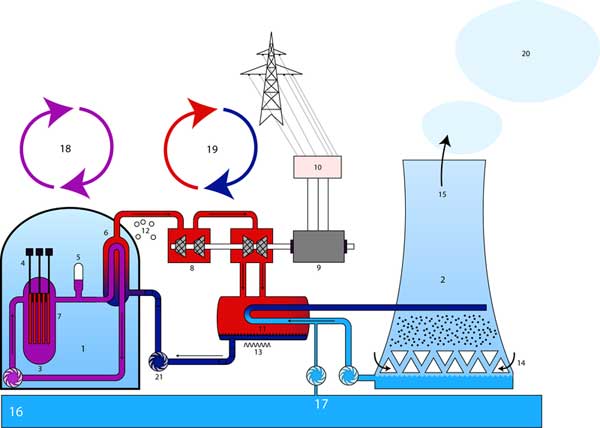
Design of a nuclear power plant with pressurized water reactor (PWR):
|
1. reactor block 2. cooling tower 3. reactor 4. control rod 5. support for pressure 6. steam generator 7. fuel element 8. turbine 9. generator 10. transformer 11. condenser 12. gaseous 13. liquid 14. air 15. air (humid) 16. river 17. cooling-water circulation 18. primary circuit 19. secondary circuit 20. water vapor 21. pump |
When living organisms are exposed to the low amounts of background radiation there is very little affect overall on the organism. When radiation exposure of larger amounts occurs, even if it is for a short time, damage, radiation poisoning, and even death can occur. The scientific community has not reached consensus7 on the effects of very low doses of radiation (less than 10 rem) as is described by Radiation Answers Organization, a website created by the Health Physics Society consisting of experts in this field. However, scientists are in complete agreement that doses greater than 50 rem cause observable health effects. The unit “rem” is the amount or dose of radiation someone receives. The Radiation Answers Organization has a table describing the effects of radiation on humans at the Radiation Answers Organization website. Many questions of concern about issues from irradiating our food to the effects of granite countertops8 (all safe don’t worry!) are addressed at the Health Physics Society’s fact sheets web site, and their frequently asked questions web site.
The experts have determined that exposure to doses of 10-50 rem may increase your chances of cancer, and will have observable short-term effects on blood cells. Doses between 50-100 rem over a short time have observable affects, and over a long time will increase your chances of cancer. Above 100 rem, if you receive the dose in a short amount of time you might experience nausea and would require medical attention. Above 500 rem in a short amount of time may cause death within a few days.
We’re radioactive

If you eat a banana a day for a year you are exposing yourself to about 3.6 mrem because of the potassium in the banana, but don't worry it's not enough to harm you.
In our everyday lives we are exposed to 5 mrem of radiation each time we fly roundtrip across the United States. A reasonable average amount of radiation in our homes from the production of radon gas (occurring naturally) is about 200 mrem per year. Even our own bodies have radioactive isotopes! Potassium-40 is a naturally occurring radioactive isotope, and although it is not a high percentage of all of the potassium in the world, it does account for 0.012% of the entire world’s potassium. We require potassium to survive and 0.012% of our body’s potassium is radioactive. We expose ourselves to 40 mrem each year due to the decay of naturally occurring radioactive isotopes in our bodies! Bananas are loaded with potassium; kitty litter, and plant fertilizer contains it too. If you eat a banana a day for a year you are exposing yourself to about 3.6 mrem.9 Cigarettes are very dangerous, besides all the other bad things in cigarettes they may contain polonium. Smoking a half a pack of cigarettes per day adds 500 mrem each day. The average person in the United States receives between 100 and 400 mrem each year depending on where they live. There is a form from the American Nuclear Society, which you can fill out to determine your approximate dose of radiation each year.10
References
1. Princeton’s Open Source Radiation Safety Training, Module 3: Biological Effects
2. Radiation Therapy: Cancer Treatment Centers of America (CTCA)
3. http://www.cancercenter.com/conventional-cancer-treatment/radiation-therapy/therasphere.cfm
4. The National Cancer Institute
5. Cassleman, B, Smith, R., How Nuclear Reactors Work…And the Dangers When they Don’t, Wall Street Journal, 15 March, 2011, Interactive, A Visual Guide Inside Japan’s Reactors NPR, 14 March 2011










